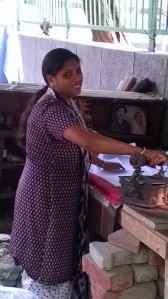As a member of the Church of Jesus Christ of Latter-day Saints, I belong to the women’s organization within the church called the Relief Society. Regardless of where I live in the world, getting to serve with other women in this organization is wonderful. Every couple of months, the local organization of this Relief Society holds an activity that is centered on strengthening faith, the family, or the community. This past Saturday, I was able to go with these wonderful women to visit Mother Teresa’s Orphanage here in New Delhi.
Mother Teresa was born in Albania but lived most of her life in India, and became a citizen of this nation. She came to India in 1929 and started teaching school near her convent. Two years later she took her vows to become a nun. In Calcutta she began a mission to serve the “poorest of the poor” where she started tending to the needs of the starving and the destitute. It began with a very small group of 13 people serving the needs of those in Calcutta. Today it is an international charity with over 500 missions in more than 100 nations.

Outside the orphanage with the women of our Relief Society and one of the “sisters” serving in this mission.
Two of the women in our group had been involved at this mission before and gave us a few instructions. Number one is that they do not like pictures to be taken so unfortunately I have few to share. Second, they explained that these children often do not get much touch so just touching their arm or holding their hand is something we could offer. We brought juice boxes, a small cupcake for the children, some new small stuffed animals and smiles to share.
After removing our shoes and being greeted by one of the “sisters”, we were taken upstairs to meet the residents of this mission. In the babies room there were 20 small metal cribs lined up in rows right next to each other. Everything was very clean and orderly. Two babies laid in their cribs, carrying fevers and not feeling well. Sitting in the long hallway were chairs similar to high chairs, but closer to the ground, where many children were sitting and we could greet them. We blew bubbles with them and they loved the feel of it and “popping” them. One of these children had a really hard time saying good bye to one of my relief society friends as she didn’t want the hug she was giving her to ever end.

One of the girls that loved blowing bubbles with me.
In another room we sat at some tables doing some small activities. I sat with three completely blind girls at a table. One loved grabbing my hands and just moving them to clap them. When the music was playing, they loved to listen to it and move their hands and heads to the beat. The best surprise for me of the day, though, was seeing three of the individuals that I see regularly at a non-profit group for young adults with disabilities. It really stirred something within me to see these women there and know a little more about their backgrounds as I see them each Tuesday.
We asked a worker there how these individuals end up at the orphanage. She explained that some are just dropped at the door, others are brought in because they are found alone and homeless on the streets and it is here where their basic needs are fulfilled. I was so impressed with the staff and the “sisters” of the mission. Upon leaving we got to peek into the section where the “sisters” go to pray and worship. It was a great day in India and one where you have to say, Wow! How incredible to go and actually be in one of Mother Teresa’s orphanages and to see the good that her life here on earth is still providing to so many with far too little.


































